| |
War Plan 1951: Railway Denial Mission
From the very first days of the Cold War in Germany, barriers,
obstacles and special missions for the limited US Army Engineer
units in Germany were central to war planning. It is a largely
untold story and a chapter takes place in Bad Kissingen.
Major portions of the following article appeared in The Army
Engineer Magazine, Sept - Oct 2002 issue, as written by Col (Ret)
Ray S. Hansen and BG (Ret) Robert M. Wilson. They were troop leaders
with first hand experience with the mission. If anyone would like a
photocopy of this article, please contact the web master and we will
send it along. They also generously provided additional information
by telephone and e mail. Bill Burr, a trooper in one of the key
engineer units, provided great recollections and photos. Special
thanks to the family of Col (Ret) John V. Parish, who also provided
photographs.
1st Platoon, Company C, 18th Engineer Battalion: BK and the Big
Bang
Col (Ret) Hansen and BG (Ret) Wilson:
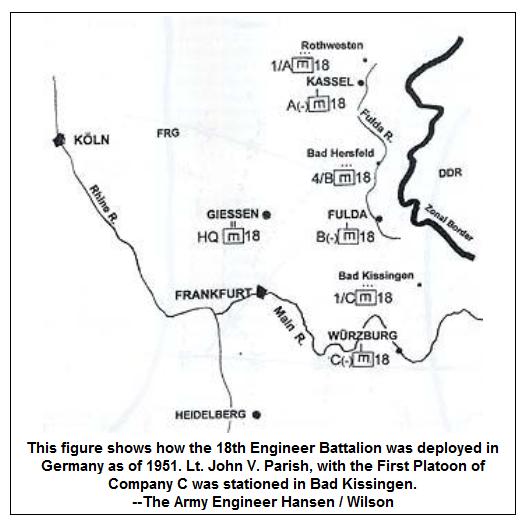
"NATO allies were ill prepared to resist a Soviet attack, if it came
in those first days of the Cold War. Germany was still an occupied
country, and had no armed forces. British, French and US units in
Germany had been organized for occupation duties and not for defense
against a former ally. The only major US units were the 1st Infantry
Division, the US Constabulary and the 6th Infantry Regiment in
Berlin. Engineer units were limited at best and the still powerful
Red Army kept 20 plus divisions in East Germany, with ten more
behind those and a total force of 2.5 million troops."
"US planners realized that at best, the
current allied force could hope to wage a delaying action in the
event of attack and the Rhine River would be a major obstacle in the
planning. Further, they realized that the Soviets relied heavily on
rail for logistics and heavy equipment. Massive interdiction of West
Germany's east - west rail system would be required to impede
movement of bridging equipment for Soviet crossings of major rivers
such as the Main and Rhine. For this vital mission, the Pentagon
ordered two units specially created and deployed. The 18th Combat
Engineer Battalion was organized in Germany in 1950, the 485th
Combat Engineer Battalion was called up from Reserve status, fitted
out at Fort Belvoir and arrived in Germany in 1951."
When LTC Spurrier led the 2nd Recon Battalion from Schweinfurt to
Bad Kissingen in 1951, one of the other units that also soon moved
to Manteuffel Kaserne was the 1st Platoon, Company C, 18th Engineer
battalion. Their mission was simple, to study the assigned railroad
bridges and tunnels in their sector, a corridor running southwest
from the border towards the Main River and beyond and develop
detailed plans to, in the event of war, destroy them with
conventional explosives. From Rothwesten in the north to Wuerzburg
in the south, other platoons and companies of the 18th were
similarly analyzing their own target lists.  Col (Ret) Hansen was located in Fulda and BG
(Ret) Wilson and Bill Burr were in Wuerzberg with the 18th and their
experiences would certainly be similar to those of the engineer
platoon in BK. Their recollections help set the scene in Germany as
the denial mission began. Col (Ret) Patrick D. Tisdale MD and Harry
W. Thibeault tell the story from the Bad Kissingen perspective.
Col (Ret ) Hansen and BG (Ret) Wilson:
"In late 1950, the 555th Engineer Combat Group prepared the
Strategic Railway Denial Plan and assigned missions to the two
battalions. Sufficient targets were identified to form four
successive ' barrier lines '. Not lines of obstacles in the normal
sense, these were barriers to rail movements. They were laid out to
insure every route from the east to the Rhine would be cut by at
least four targets. Later, 7th Army added twelve targets not on
railways."
Bill Burr:
"I was a basic engineer and in the Constabulary upon arrival at my
first duty station in Germany, July of 1950. (Korea broke out in
June while I was in basic training just at the end of our cycle). I
wore the ' Circle C ' patch and all the leather for about 3 weeks.
Then we took off the Circle C and replaced it with a ' 7 Steps to
Hell ' patch (7th Army). From there we were taken to Kaufburens '
Fliegerhorst Kaserne ' . We trained there for a short time and a
number of us were sent to Murnau USAREUR Demolition School, from
which I still have my diploma. I collected my Hazard Duty Pay for
the whole time I was in the company. (( Company C, 18th engineer
Battalion in Wuerzburg )) In the early days we inspected each target
bridge and I took photos for the target folders. I would take them
to the Service Club, develop them and make matte enlargements and
add the dimensions of the abutments, girders etc. The other men
sketched the sections and put down the dimensions."
Col (Ret) Hansen and BG (Ret) Wilson:
"Each bridge and tunnel had a comprehensive target folder. It
contained maps and sketches of exact location, and charge details
such as size, placement and firing mechanism. Individually
classified CONFIDENTIAL, and as a group SECRET, they were kept in
company safes. We suspect most squads could do their jobs from
memory."
All of this required great amounts of explosives and equipment
necessary to move it. The allocation was in the order of 100 tons
per company split between tetryol, composition C - 3 and TNT. A
small fleet of trucks, trailers and jeeps was assigned to each
platoon; they were authorized to exceed normal weight and cube
limits to transport the loads. All the vehicles were kept loaded and
parked in special, secured remote sites. While each platoon had
sufficient equipment to move their explosives in a single lift,
there were additional stores at Wetzlar, Hanau and Munster. There
were no significant accidents but both Bill Burr and CWO 4 (Ret)
Charles Wright recall close calls.
Bill Burr:
"I can remember one day (my secondary MOS was driver of the HQ
platoon's 3/4 ton ).
We had been called out on alert, my W/C was in
ordnance for some repair which landed me as a passenger in the rear
of a 2 1/2 ton truck. (No explosives on board). In Nuremburg (I
believe) the convoy stopped. After a 10 minute wait, we started to
move again at a fairly high rate of speed. We passed another 2 1/2
which was off on the side of the road. That was one of the fully
loaded
demo. trucks. The guy driving was an assistant driver, with no
driving experience, other than barely passing the test and he had
never driven anything prior to joining the Army. He had failed to
release the emergency brake, which had caught fire. The CO (CPT
Rogers), the First Sgt. and the driver were frantically throwing C-3
satchels off the back of the truck onto the side of the road. As
this was happening, an EES (European Exchange Service) panel truck
came by in the opposite direction, saw the commotion and stopped.
The driver brought out an old pyrene fire extinguisher and proceeded
to help put the fire out. Had that man known what was in the truck,
I think he would have burned tires getting away from there. Needless
to say, if it had gone off, sympathetic detonation probably would
have taken the whole outfit and a good part of Nuremburg with it."
CWO 4 (Ret) Charles Wright, stationed in Fulda, recalled :
"We had a report of one convoy going through Gelnhausen and trying
to maneuver through those narrow streets when they lost sight of the
other trucks. The driver increased speed to catch up and reached a
fast pace as he rounded a corner, then he found the convoy stopped
and plowed right into an explosives filled trailer. There was
tetrytol all over the place. They cleaned the scene up and got the
trailer going again and made it back to Fulda."
Even in those early days of the Cold War,
consideration was given to not alarm the local population and what
must have been a disturbing scene, American GIs constantly standing
next to major railroad bridges and tunnels with clipboards and tape
measures, soon became a thing of the past.
Col (Ret) Hansen and BG (Ret) Wilson:
"On 17 March 1951, 7th Army issued an order prohibiting practice on
actual assigned targets. Neither real or dummy explosives were to be
placed, even under cover of maneuvers. Targets could be measured or
sketched only by small parties under cover of maneuvers."
Beyond the war mission, the companies and platoons also followed a
normal training schedule to maintain their engineer skills. To gain
access to the full set of engineer equipment, they had to closely
coordinate with the few fully configured engineer units in that part
of Germany. Construction and the standard field tasks for engineer
units plus the normal menu of individual soldier skills were central
features of this training. It is perhaps in this light that Lt. John
Parish in Bad Kissingen, was able to get his men involved with the
construction of the air strip at Reiterswiesen.
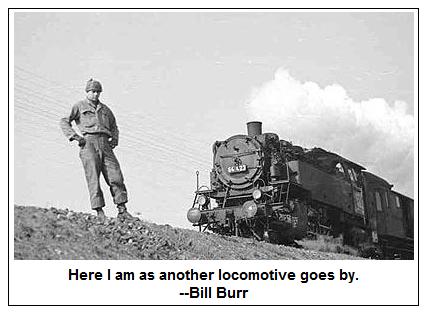
Harry W. Thibeault:
"I was in Bad Kissingen for 18 months, starting in 1952 and was
assigned to the demolition platoon. I was a driver and also had
explosives training. We kept the trucks and trailers fully loaded
and parked in our own separate area at the barracks. We guarded it
day and night. We also kept an empty truck by the orderly room door
or wherever the platoon was to carry us all to the motor pool fast
if there was an alert. I do remember working on some civil
construction projects for the Germans and the ' alert ' truck always
followed us. Our barracks was in good shape and there was a medical
platoon living in our area."
"We would inspect the targets now and then; I recall we had one big
tunnel that required explosives set in chambers at one end and also
in the middle. So, one day we are at that target looking at the
chamber in the middle and it was pitch black except for our flash
lights. The chambers had big steel doors that we swung open and
somehow in the dark, I tripped over a rail and fell against the edge
of a door. I hit me knee and I never felt such pain in all my life!
33 years as a municipal fire fighter and that one day in Germany was
the worst! I couldn't walk and they had to wheel me out of the
tunnel on a cart! The medics gave me a few days off until the
swelling went down."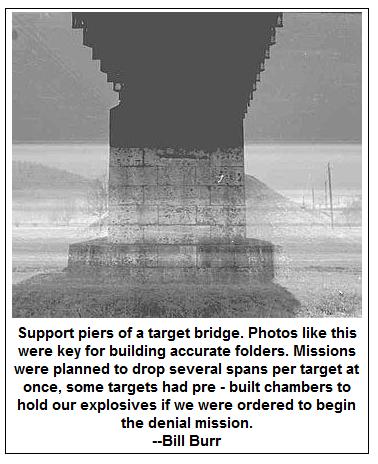
"I recall that we had very limited over night field duty, our
mission was those trucks loaded with explosives so beyond
engineering work we did in town and regular training, there were no
FTXs. I also recall that the platoon integrated while I was there.
The Platoon Sergeant announced one day that it would happen and
said, ' ... there better be no trouble!'. There were some all black
engineer platoons in Germany that were broken up and each unit
received something like 10% of the unit roster, so we got three or
four guys. I guess it went OK, I don't remember any big trouble."
"BK was pretty and we did what soldiers do,
ran around, chased girls and bought some beer. One guy got paid and
got on a train out of town. Well, I guess he got in trouble and lost
his money so he started to walk back by following the railroad
tracks. You wouldn't think it but those German steam trains were
fast and quiet and they found the body sometime later. There was an
investigation to see if he was AWOL or what, it had to do with the
benefits to his parents. It was a sad story, but almost everything
else I recall from my Army job was good."
Col (Ret) Patrick D. Tisdale MD:
"I followed Jack Parish as the First Platoon leader of Company C ,
18th Engineers and it has been a very long time since I gave any of
this much thought. The junior officers in the battalion were rotated
around each year or so; I had time in Wurzburg, Bad Kissingen and
Fulda, some of the memories blend together."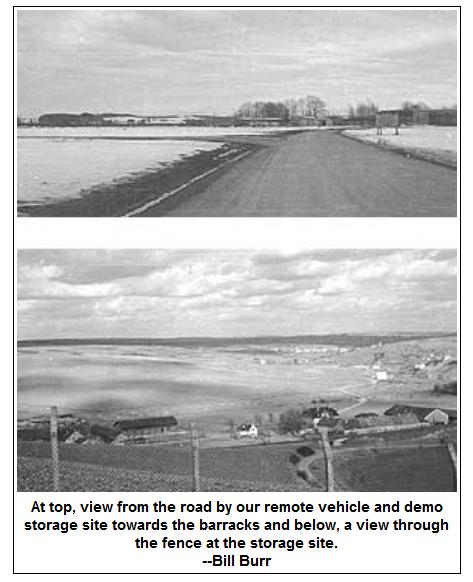
"In BK, I lived in a hotel in town but cannot recall much about it.
I bought a really nice camera soon after arriving in BK to update
the target folders, took the photos and then gave the camera to my
Platoon Sergeant as a gift. I never was much for photography beyond
what was called for in the job. In general, I recall we were busy
and leave was almost unheard of if you were the Lt. or a senior NCO.
There really was a feeling that we would be called out to destroy
our targets at a moment's notice."
"Three targets remain clear in my memory. Near Bad Kissingen was a
large tunnel that was our responsibility. We were to destroy both an
end and the middle, explosives chambers were built and this target
required a great deal of explosives. We figured we could drive the
truck and trailer into the tunnel but this would be very slow so we
looked for alternatives. On another railway line, we found some
German ' right of way ' maintenance carts that were fitted with rail
wheels. They were ideal to load and then push by hand down the tacks
so ... we liberated them and hid them in the woods near the tunnel
entrance. Another target was a steel railway bridge that I recall
looking at first as a trained civil engineer. It was a beautiful
bridge, long and sweeping using just enough steel to bear the weight
of the trains from pier to pier. Because it was so carefully
designed, it was also a very easy target to destroy. Just a few
charges at the critical points and it would have dropped straight
into the river. In Fulda was a tunnel that ran across the border and
this was the only target that had been loaded with explosives and
under constant guard by an engineer squad."
Erwin Ritter adds the detail concerning the Fulda tunnel:
"Yes, between Schwebda / FRG and Geismar / DDR, was a 1066m long
railroad tunnel. The name was "Frieda-Tunnel". The tunnel is closed
now and the railroad does not exist any longer. The line was closed
in 1945, at the end of the war, because one of the bridges near the
border was damaged. In the 1980s the tunnel was filled up with
stones."
As more US troops flowed into Germany and "first battle plans"
became more refined, the mission of the "destruction" battalions
began to recede as new engineer units took over the denial and
barrier plans. In 1957, the 18th Engineer Battalion was deactivated
as a "demolition battalion". The 485th had departed two years
previous. The bridge destruction mission by the 1960s, became an
atomic demolition munitions story.
BG (Ret) Wilson:
"To the best of my knowledge, the engineer platoon in BK never
returned to the parent company in Wuerzburg. For as long as the
railway denial mission existed, there were targets near BK that
could not have been reached in time from Wuerzburg (C Company also
had another detached platoon, the 2nd platoon attached to A Company
in Kassel. They never returned either.) When the 18th was
inactivated in 1957, its personnel (except those due for rotation)
were reassigned to other engineer units in Germany. Probably a good
number of the 1st Platoon guys stayed right there in BK."
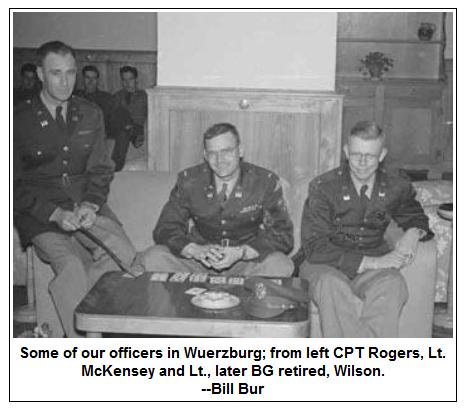
After leaving Bad Kissingen, Lt John V. Parish, later Colonel (Ret),
went on to a long and distinguished career to include service in the
Middle East, Vietnam, the USA and Germany. Col. (Ret) Patrick D.
Tisdale MD, left Germany for a stateside assignment at Fort Belvior
then went to medical school. He returned to active duty as a
physician and became one for the lead pediatric doctors in the US
Army over a thirty year career.
|
|